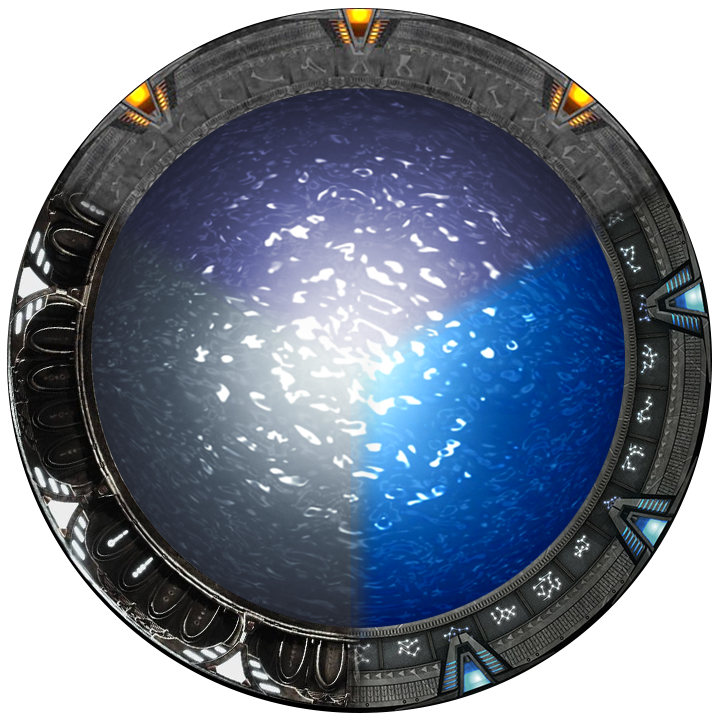They call it the “fabric of reality” because that’s a good metaphor to describe how gravity works. (Or at least I assume that’s where it came from, I could very well be wrong.)
When you stretch a fabric thin, and place something heavy in it, it’s going to sink and stretch the fabric down with it. Then, if you place a smaller object next to the larger one, it’s going to roll around the larger one, gradually moving closer as it goes down the slope created by the larger object.
That might be hard to visualize, so here’s a neat video I found.
Edit: guys I think you’re reading too much into this I wasn’t trying to provide a foolproof explanation of how gravity works I was just trying to relate an interesting metaphor to a piece of linguistics.
And I wasn’t even right, a quick google search says the term predates our understanding of the universe. Its probably a coincidence.
One could be picky and say you’re explaining gravity with gravity. But for the sake of simplicity that’s OK.
I’ve once read an article where someone complained about that and tried to explain it with the actual cause, curvature of space time, like using a model car with glue attached to the wheels. But that was not really intuitive and simple to understand.I found a video once where the guy built a device to demonstrate curving based on mass, to avoid the gravity simulating gravity problem, but I failed to find it again when searching. It was something he’d bend to show larger mass, and you’d see the effect with the bands along it or something. Even that isn’t accurate, but visualizing 4D can be challenging, especially if you then have to put it in 2D media.
Here, probably this one. The only good explanation I’ve seen.
Exactly that one. Thanks, I’m glad I said something. It wasn’t anything new, just a new way to present it, and when he did the warped version and the straight line, I was like, okay, makes sense. Then he returned it to our “viewpoint” on the warped space seeing things straight, and even though it was the same lines, it was amazing to see those paths go precisely where we expect. All because of a warped graph. I think it was more incredulous because it wasn’t some animation, but a physical demonstration.
I think of it as a 2d cross section of the experiment (it’s happening in every direction possible tangent to the ball), which necessarily breaks into a third dimension. In our 3-spatial-dimension reality that’s the best we can do.
Yes, but the smaller object is dragged into the valley formed by a heavier object due to gravity (of the earth), not due to following the curvature of the blanket.
Sure but it is still a cross-section of what it is — something with a mass of that bowling ball being gravitationally attracted to something the mass of Earth. The blanket is a demonstration of what spacetime is doing (how it’s being warped) by the gravitational attraction. It so happens that you can also sort of demonstrate how another object can be influenced by the bowling ball’s gravity as it’s being gravitationally attracted by something else (like how a small object would be attracted to the moon which is still being attracted to Earth). Given that nothing can really ever be gravitationally unbound, I think it’s a fine demonstration. I wonder if you’re expecting it would demonstrate something it isn’t demonstrating (like how an object in isolation would influence some other object in isolation).
I find the metaphor frustrating because of that.
This video includes a much better representation of what gravity is IMO. The creator had the same issue with people describing gravity with gravity.
deleted by creator
It’s worth noting that spacetime isn’t static. Space “flows” into mass. It’s akin to a treadmill, you need to constantly move “upwards” to stay in place.
This is also the reason that uniform gravity, and acceleration are identical. With acceleration, the “ground” is constantly moving upwards into new space, pushing you along. With gravity, space is constantly moving down through the floor, trying to push you into the floor. It’s functionally the same thing.
That’s a really interesting perspective. I don’t think I’ve ever seen it described that way before, but it’s very easy for me to grasp. Do you have any resources I can look into for more information? Does that concept have a name I can look up?
It was the initial description used in my 1st year physics degree course. Not sure if it has an explicit name. We also jumped fairly quickly from there to the maths.
Basically space time can stretch infinitely, and flows towards mass. Anything on that spacetime is drawn along. It’s functionally identical to a standard force. Straight lines twist into spacetime spirals (aka orbits etc).
Physics has lots of interesting mental models for different things. Unfortunately, most are flawed, so dont lean on tgem too hard. What actually happens is way beyond what our monkey brains can interpret. The best we can do if follow the maths, and try and fit something to the end result.
Yeah, I’m aware that all or numbers and models are, at best, representative of what is really happening. That’s what I love about the limits of our knowledge: there always something more to learn.
I wonder how spacetime around a black hole’s ergosphere is represented by the “flow” analogy. Maybe like water swirling around a drain?
I think that explains the “how” more than the “why”.
What I meant was that’s “why” we use the term “fabric of reality”— because of “how” gravity works.
Indeed, it’s a neat way to visualize gravity, but that’s it. It lacks any sort of explanation of why masses appear to be pulled towards one another. (I will point to the other person in this thread saying it “explains gravity with gravity”.) This is why I think the metaphor you mentioned detracts from the original video.
Can spacetime be ripped or torn? Or is the fabric metaphor simply a way of understanding and visualizing it?
If cosmic inflation is correct, probably not. Inflation is our best theory of the beginning of the universe.
According to inflation, spacetime expanded exponentially from an infinitesimal point to many billions of light-years across. As far as we can tell, the universe is expanding again but at a much slower rate, due to dark energy.
Spacetime survived the inflationary period, so it looks like it doesn’t have a “tear” mechanism.
Another way to think of it, is to assume once torn, what is it tearing “into”. If you rip a bit of fabric, you look through to the other side, nothing special. If you tear our 4-dimentional spacetime, what are you looking at when you look “through” the ripped portion? This implies that out 4D spacetime is somehow existing in a higher dimensional reality.
It would make black holes more interesting if they were tears, anything over x mass just ziiiiippppp
Oh. That’s a thought
i’m aboslutely certain it’s bunk or science would have been all over that. Feels right tho…
One could argue that’s what primrose squares show. In fact I think that’s how primrose came up with them
https://m.youtube.com/watch?v=4v9A9hQUcBQ&pp=ygUacHJpbXJvc2Ugc3F1YXJlcyBzcGFjZXRpbWU%3D
Can spacetime be ripped or torn?
That would probably be analogous to false vacuum decay; don’t try to make it happen
What if it is getting ripped/torn but there’s just more space ‘underneath’ that instantly fills the gaps as they are created? I guess at that point it’s indistinguishable from stretching but it’s interesting to think about
Or, if you prefer, here is “Einstein” explaining it.
Not gonna lie I really thought it was gonna be Neil DeGrasse Tyson
deleted by creator
Bending spacetime.
True. But that correction still doesn’t unbend my mind
Nor mine!!
Oh yes let’s talk about my favourite subject ever!
The coolest thing I know of comes from wondering why bent spacetime makes you move at all. The answer is that you always move through time and the bending of spacetime actually turns a bit of time into space and vice versa.
Unnecessary tangent
For a horrible but intuitive explanation of how this works, time is kinda just a direction and bending sorta rotates things so that time looks like it’s one of the space directions. Just like turning to the left makes what was your left look like it’s straight ahead.
This leads to my favourite saying about black holes, once you enter them you can no more escape falling to the singularity than you can escape tomorrow.
I’ve never heard that take on it before (the idea of turning time into space), but it sounds fascinating. Do you have any links I could follow up on?
Only a few really dry textbooks I’m afraid, it’s a subject that’s extremely difficult to explain in lay terms as the mathematics is so complicated.
That said if you’re feeling masochistic, Schultz’s first course in GR is the most approachable that I know.
I really like this PBS Spacetime video, which is at least a little related. Great channel for diving into these subjects further, but in a more casual way than a textbook.
Yes! About that aspect of turning either into space movement or time movement - everything is constantly moving, either in space or in time. I like to think of anything moving (which is everything) as having to plot itself on a X,Y chart where X is space and Y is time. If you trade all your movement/momentum so that you experience no time (like a photon of light for example), then you’re moving as fast as you possibly can in space. The less of that movement through space, the more you experience the rate of time.
Oh god the case for a photon is super hard to talk about in any meaningful way, photons “see” every point in their journey as happening at the same instant of time and at the same place, null geodesics are nuts.
But yeah, the underlying mathematics that causes this can (kinda) just be pinned on the normalisation of the four velocity, which I think is what you’re describing.
So gravity is some kind of derivative property of entropy? I’m out of my depth here. Did anyone ever define time properly?
Instead of remaining parallel as we move through space in the arrow of time, we get closer to other mass because our paths bend, our clocks running at slightly different beats.
Time-bending is mind-bending stuff, man.
An object will always follow the shortest path between two points in spacetime.
When it’s sitting alone in the universe, the shortest path is to move through time from A to B.
When other things are present to also curve spacetime the shortest path can entail accelerating in space and slowing in time (from the viewpoint of us, the omniscient massless observer floating nearby pointedly not having any casual interactions).
Variational principle goes brrrrr
It’s possible that time causes gravity.
Matter bends spacetime. Spacetime tells matter how to move.
Using this logic, you can imagine that above a certain threshold, this can become a feedback loop. These locations are black holes, where enough matter located in a small enough volume of spacetime can create enough distortion to further force more matter into the same volume of spacetime.
How similar is this process to low/high air pressure systems?
One mind-altering fact that I love is that there’s no “acceleration due to gravity,” once you’re in free fall, until you hit the ground. Hop in a space ship with no windows and fly off straight in some direction. Turn off the engines and watch an accelerometer. It’ll never read anything until you run into something.
You could fly past a planet, a massive star, even a black hole. Your path through space could be full of curves and loops but you’ll never feel it. It’s popular to think of those things as like crazy high G turns but they’re not. You’re just flying in a straight line through space time.
On the flip side, say someone knocks you out and puts you on that ship. You wake up and instead of being weightless, you can walk around the ship like normal on earth. Are you on earth or is the ship in space accelerating at a constant rate? Again, there’s no way to tell. They are, physically, the same.
It’s popular to think of those things as like crazy high G turns but they’re not. You’re just flying in a straight line through space time.
Soooo… Interstellar was wrong with all the shaking of the camera?
Are you on earth or is the ship in space accelerating at a constant rate? Again, there’s no way to tell. They are, physically, the same.
In case of accelerating ship, I wonder what would happen in local frame once you hit/get really close to c. You’d get decelerated out of nowhere? Just as if you hit something?
Soooo… Interstellar was wrong with all the shaking of the camera?
All for the cinematography :) I will say that there’s a small caveat in really extreme situations like close to a black hole. Spacetime gets so warped there that your head and your feet take very divergent paths through spacetime, enough to stretch you out and even break you apart at the atomic level. You’d definitely notice that…
In case of accelerating ship, I wonder what would happen in local frame once you hit/get really close to c. You’d get decelerated out of nowhere? Just as if you hit something?
Oh boy, special relativity is another fun one. So here’s the thing: there’s no “universal speed” that you’re moving so you’re never any closer to c no longer how long you accelerate for. To accelerate is to change your reference frame and there are no special reference frames.
Which is to say that any physical test you could run inside your ship will give you the same result, always. Accelerate for 13 billion years at any rate and check the the how fast light moves within your ship, the answer is always c.
This is where the name relativity comes in. You have to think in terms of relative speed. Your speed relative to earth will indeed advance closer and closer to c but never reach it. There’s a bunch of really wild and crazy implications behind this.
Like that acceleration doesn’t change the relative speeds of things uniformly. Keep accelerating at 1 meter per second per second and every second Earth’s relative speed changes by less than 1m/s. And look up relativity of simultaneity, another consequence of special relativity. It’s fascinating stuff.
This is where the name relativity comes in. You have to think in terms of relative speed. Your speed relative to earth will indeed advance closer and closer to c but never reach it. There’s a bunch of really wild and crazy implications behind this.
ah, right. In a ship travelling with c, for someone outside the ship, I turn on the lights and observe the light to travel with c. For that external observer the light from my lamp travels at the same speed as my ship
My mind was already bent! ;)
This is a pretty accessible visualization of gravity.
But it’s kind of a terrible one, because it uses gravity to explain gravity.
It’s just meant as a physical analogue to demonstrate some features (namely how the shape of the sheet/gravity affects things that travel on/through it) in a way that people can understand easily.
If it’s the demonstration I’m thinking of, it uses gravity to visualise the affects of an otherwise invisible force.
Gravity is not instantaneous. It moves at the speed of light. And the “speed of light” can only be measured locally, because the time and space at a point are curved. The path of light corresponds to “null geodesics” in spacetime, and a body traveling along the geodesic experiences no time elapsed.
I once came across information that said natural forces never pull. They only push. If that’s true then magnetism and gravity are even more confusing than I had initially estimated.
I once came across information that said natural forces never pull
That’s absolute nonsense. Discard that thought and never repeat it again.
I’m not following the logic.
Massive things cause gravity. We experience this, of course, as the earth pulling us in towards its center of mass.
But if gravity pushes, then what is it that is getting on the other side of me and pushing me towards the earth?
Where is the physical origin of that pushing force?
How does it know to get on the far side of me and push me “down” toward the giant mass that is the earth?
None of it makes sense to me. I hope it’s true and things are just that weird.
This is the explanation as to why gravity is not a force
I learned this from The Sound of Science https://sos-cis.bandcamp.com/track/gravity. It’s actually a great album. Unlike lots of educational music, this album is produced to an adult standard.
I have such a hard time accepting that this isn’t something almost everyone knows. It’s such basic knowledge, it’s taught in schools and mentioned often enough in any kind of media etc. Seeing this thread is like finding out people don’t know that fries are made of potatoes.
I can’t speak for anyone else but I definitely didn’t have gravity explained in school as the rotation of an objects 4-vector due to a temporal gradient.
Hey everyone get a glimpse of this loser!
The understanding I got from school was that gravity might be some kind of force and basically one mass attracts other mass, like electric potentials do
Keep in mind, that was 20 years ago. Our understanding might have changed and tbh I wouldn’t expect a high school physics teacher to be on the bleeding edge of research in all physics fields
If this surprised you…You’re in for a world of hurt when you realize how little we all know
Start to specialize in one thing like a trade or a hobby and you’ll find the world chock full of information with no possibility for anyone to learn or even familiarize themselves with
Hey now, I wouldn’t say that. I’m a super-interested individual when it comes to physics, astronomy and the like and I feel like I have a decent grasp on the lay-versions of what we seem to know as of 2024. But I also know that I’m constantly on the hunt for new information, documentaries, etc. on the subject. Ain’t no way that “almost everyone” is putting nearly the same amount of time being interested in this subject matter. This isn’t pop culture (though maybe it should be😉).
Yaaay. Here, for your skills in understanding of space and time better than random internet you get the “I am smart” award.
I’m sure I’ve read about this before but I couldn’t say I really “know it”. It’s not something that ever comes up in my day to day life so I haven’t internalized it and probably wouldn’t be able to answer correctly if someone asked me how gravity works. I’d probably give the if first explanation about objects attracting each other with mass because that’s much more intuitive to me for whatever reason.

















